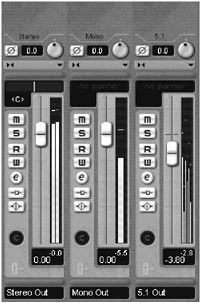Output Bus Channels
| [ LiB ] |
Output Bus Channels
The output bus channels represent each output you have created in the VST Connections panel. How you use the output buses you create depends on the project at hand and the number of available outputs on your sound card. Depending on how you set up your system or how many outputs your sound card has, you will generally use the two main outputs of your sound card to monitor your Cubase project. If you have more than two outputs (and probably inputs), you can use these additional outputs for additional buses. These additional buses can serve to feed an external effect processor, a headphone amplifier , another recording device, or a multispeaker monitoring system typical in surround systems.
Each output bus you create in the VST connections will appear when you make the output bus channels visible in the Mixer. You can also change or create bus output configurations through the VST Connections panel (F4 is the default key command to access the panel). If your sound card only offers a pair of stereo outputs, then creating a single stereo output bus and perhaps two mono output buses should be enough since you can't separate the signal on its way out anyway (besides the two mono signals). If you want to group a series of channels together and control their settings as one group, you should use a group channel rather than a bus.
Output buses, like other audio channels, can also have up to eight (five in SL) different assignable insert and send effects. Assigning effects to output buses can be useful when you want to optimize the overall level of a project, want to down-sample your project from 32-bit (or 24) to 16-bit by using dithering, or simply want to add a subtle reverb on the entire mix. Then again, output buses don't have to be used only for mixing purposes as mentioned earlier. The last two insert effects on SXinserts 7 and 8are post-fader, contrary to the typical pre-fader insert configuration. In the SL version, only the insert 5 is post fader.
When a project's sample record format is set to 32-bit floating point, you don't need to worry about digital clipping on audio channels after the channels are recorded and there was no clipping at the input. That's because the processing inside Cubase is done using this 32-bit (floating point) format which makes it very difficult to actually get digital clipping. However, after the signal is sent to the output, it is converted to the sound card's format; in many cases, this is 16-, 20-, or 24-bit. Because of this binary downsizing, digital clipping becomes a very real possibility if the clip indicator lights up above one of the output (or input) bus channels (see Figure 12.14). You should try to avoid any clipping, especially when you are preparing a final mix from your output buses. The clip indicator is located below the Bypass EQ button in each bus output. You will also notice that there are no sends on output buses. The remaining controls in the output bus channels are the same as in any other audio channel.
Figure 12.14. Output bus channels in stereo (left), mono (center), or Surround (right) configuration (SX only).

If you are using SL and would like to use inserts to prepare a final mix using an overall dynamic maximizer or dithering plug-in, you can create a group channel that will act as the main outputs for your project, include the automation on this channel if you wish, and then send the output of this group to the main output bus where you add the desired inserts, making sure you don't record any automation or add any EQ on this output bus. By doing so, you are tricking Cubase into thinking you are applying effects as post-fader since the fader of the group where the desired mix lies is before the inserts you just added to the main output bus.
NOTE
 PREPARING A 16-BIT MIXDOWN
PREPARING A 16-BIT MIXDOWN
If you are preparing your project for a final CD mixdown and want to convert the files from 32- or 24-bit to 16-bit, you should apply the UV22 dithering plug-in effect as your last insert effect for the bus containing the audio content.
| [ LiB ] |
- Chapter I e-Search: A Conceptual Framework of Online Consumer Behavior
- Chapter IV How Consumers Think About Interactive Aspects of Web Advertising
- Chapter V Consumer Complaint Behavior in the Online Environment
- Chapter X Converting Browsers to Buyers: Key Considerations in Designing Business-to-Consumer Web Sites
- Chapter XIII Shopping Agent Web Sites: A Comparative Shopping Environment